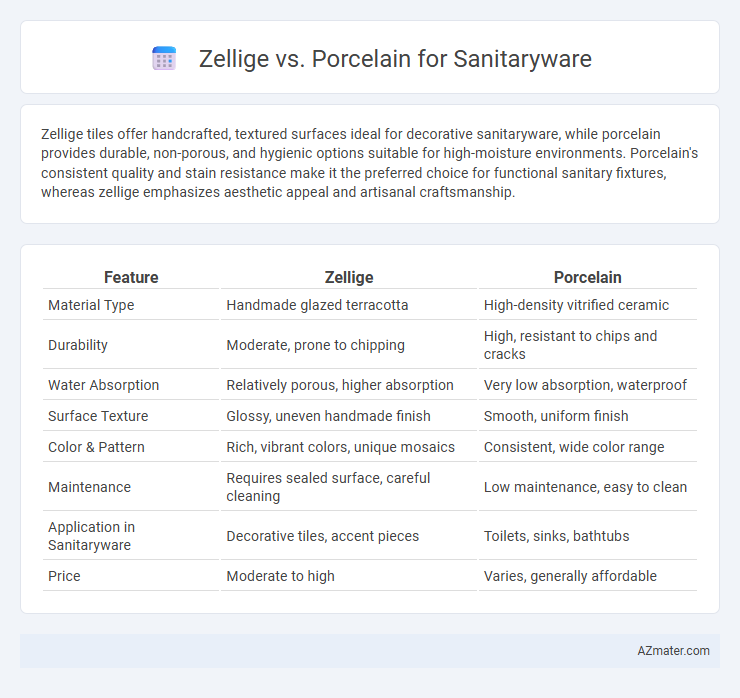Zellige tiles offer handcrafted, textured surfaces ideal for decorative sanitaryware, while porcelain provides durable, non-porous, and hygienic options suitable for high-moisture environments. Porcelain's consistent quality and stain resistance make it the preferred choice for functional sanitary fixtures, whereas zellige emphasizes aesthetic appeal and artisanal craftsmanship.
Table of Comparison
| Feature | Zellige | Porcelain |
|---|---|---|
| Material Type | Handmade glazed terracotta | High-density vitrified ceramic |
| Durability | Moderate, prone to chipping | High, resistant to chips and cracks |
| Water Absorption | Relatively porous, higher absorption | Very low absorption, waterproof |
| Surface Texture | Glossy, uneven handmade finish | Smooth, uniform finish |
| Color & Pattern | Rich, vibrant colors, unique mosaics | Consistent, wide color range |
| Maintenance | Requires sealed surface, careful cleaning | Low maintenance, easy to clean |
| Application in Sanitaryware | Decorative tiles, accent pieces | Toilets, sinks, bathtubs |
| Price | Moderate to high | Varies, generally affordable |
Introduction to Zellige and Porcelain Sanitaryware
Zellige sanitaryware features handcrafted Moroccan tiles made from natural clay, known for their unique, irregular shapes and vibrant glazes that add an artisanal touch to bathrooms. Porcelain sanitaryware, crafted from refined clay and fired at high temperatures, offers high durability, non-porous surfaces, and sleek finishes ideal for modern bathroom fixtures like sinks and toilets. Both materials present distinct aesthetic and functional benefits, with Zellige emphasizing traditional craftsmanship and porcelain focusing on longevity and ease of maintenance.
Material Composition: Zellige vs Porcelain
Zellige is handcrafted from natural clay that undergoes a traditional firing process, resulting in a porous, glazed surface with unique irregularities and vibrant colors. Porcelain, composed of refined kaolin clay, feldspar, and quartz, is fired at higher temperatures to create a dense, non-porous material known for its durability and resistance to moisture and stains. The material composition of Zellige presents a more artisanal, water-sensitive option, whereas porcelain offers enhanced strength and ease of maintenance for sanitaryware applications.
Aesthetic Differences: Unique Looks and Finishes
Zellige tiles feature handcrafted, irregular shapes and a glossy, textured finish that creates an artisanal, Moroccan-inspired aesthetic, contrasting sharply with porcelain's smooth, uniform surface and sleek, modern look. The natural variations and slight imperfections in Zellige add character and depth, while porcelain offers a wide range of precise colors and patterns with a polished, consistent appearance. Porcelain's versatility allows for both matte and high-gloss finishes that suit minimalist or contemporary designs, whereas Zellige's rustic charm is ideal for creating warm, decorative focal points in sanitaryware applications.
Durability and Longevity in Bathroom Settings
Zellige tiles, crafted from natural clay, offer exceptional durability through their dense, hand-glazed surfaces, making them resistant to cracks and chips in bathroom settings. Porcelain sanitaryware, known for its high density and low porosity, provides superior longevity by resisting stains, moisture, and thermal shock, essential for maintaining hygiene and structural integrity. Both materials ensure long-term performance, but porcelain's engineered composition typically delivers enhanced wear resistance and easier maintenance in high-use bathroom environments.
Water and Stain Resistance: Performance Comparison
Zellige tiles, handcrafted from natural clay, exhibit moderate water absorption rates, making them less resistant to water and stains compared to porcelain sanitaryware, which boasts extremely low porosity and superior water resistance. Porcelain's dense, vitrified surface prevents water penetration and staining, enhancing durability in high-moisture bathroom environments. As a result, porcelain sanitaryware outperforms zellige in maintaining pristine conditions with minimal maintenance in wet and stain-prone areas.
Installation Challenges and Considerations
Zellige tiles, hand-crafted from natural clay, present installation challenges due to their uneven surfaces and irregular sizes, requiring skilled artisans and extensive grouting time to ensure a proper fit and water resistance in sanitaryware applications. Porcelain tiles offer a more consistent shape and size with high durability and low porosity, simplifying installation and reducing maintenance concerns in sanitaryware environments. Proper substrate preparation and waterproofing are critical for both materials, but porcelain's uniformity often results in faster, more efficient installation with fewer potential issues.
Maintenance and Cleaning Requirements
Zellige tiles require gentle cleaning methods using non-abrasive, pH-neutral cleaners to preserve their handcrafted glaze and prevent damage or discoloration over time. Porcelain sanitaryware offers superior durability with low maintenance needs, easily cleaned with standard household products without risk of surface wear. The porous nature of Zellige demands regular sealing to protect against stains and moisture, whereas porcelain's dense, non-porous composition naturally resists stains and bacterial buildup, making it more hygienic for bathroom environments.
Cost Implications: Zellige vs Porcelain
Zellige tiles generally incur higher costs than porcelain due to their handcrafted production process and unique glazing techniques, which require skilled artisans and longer manufacturing times. Porcelain sanitaryware offers a more cost-effective option, benefiting from mass production efficiencies and consistent quality at a lower price point. Budget-conscious projects often favor porcelain for its affordability and durability, while luxury designs may invest in zellige to achieve distinctive aesthetics despite the premium expense.
Sustainability and Environmental Impact
Zellige tiles, handcrafted from natural clay, offer a sustainable option for sanitaryware due to their minimal processing and renewable materials, contributing to reduced carbon footprints. Porcelain sanitaryware, while durable and low-maintenance, requires high-temperature kilns and significant energy consumption during manufacturing, leading to higher environmental impact. Choosing Zellige supports eco-friendly practices by leveraging traditional craftsmanship and natural resources, whereas porcelain emphasizes durability but with greater energy costs and resource extraction.
Choosing the Right Material for Your Bathroom
Zellige tiles, handcrafted from clay and characterized by their rich texture and vibrant colors, offer a unique, artisanal look ideal for decorative bathroom features, while porcelain sanitaryware provides superior durability, water resistance, and ease of maintenance for sinks, toilets, and bathtubs. Porcelain's non-porous nature makes it highly hygienic and less prone to staining, a crucial factor for sanitaryware exposed to frequent use. Selecting between Zellige and porcelain depends on balancing aesthetic preferences with practical requirements such as durability, maintenance, and water resistance for bathroom installations.

Infographic: Zellige vs Porcelain for Sanitaryware
 azmater.com
azmater.com